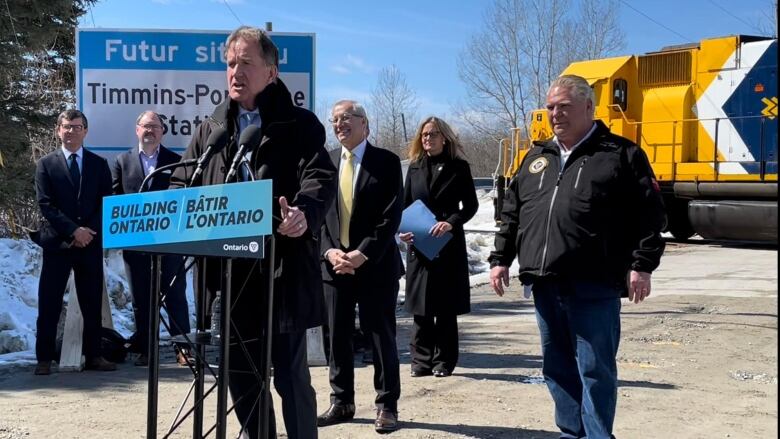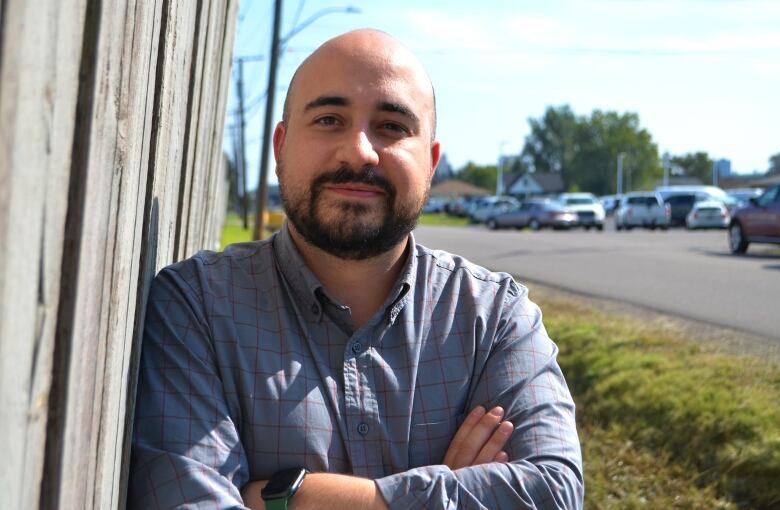Ontario mines minister says Ring of Fire could be worth $1 trillion, a figure critics call exaggerated
Wyloo Metals, which owns majority of known claims in area, estimates value of defined ore bodies at $90B

From the time the Ring of Fire was discovered in 2007, politicians and industry leaders have emphasized the potential economic value of the remote, mineral-rich area in northern Ontario.
That has intensified in recent weeks, with Ontario Mines Minister George Pirie saying recently: "Anecdotally, mining people are saying this is a trillion-dollar project."
Pirie told Global News in a recent documentarythat the $1-trillion amount was "not a formal valuation," but was "based on the increased value of critical minerals that are already established being in the ground."
Professionals and researchers in mining and resource governance have called the minister's comments exaggerated and even harmful, and possibly opensthe door to potential fraud.
CBC News sent an email to Pirie's office asking why he used the $1-trillion claim, what information he was relying on when citing possible valuations in the area,and if the province has a working valuation of the Ring of Fire.
Pirie's spokesperson, Dylan Moore, gave a brief response: "The economic potential is limitless."

When Wyloo Metals chief executive officer Luca Giacovazzi was asked about Pirie's claim, he laughed and told Global, "There is a lot of myth around the Ring of Fire [and] a number like that is way exaggerated numbers like that are a little bit silly."
But in a statement to CBC News, the CEO of Ring of Fire Metals, Kristan Straub, publicly revealed for the first time that their latest estimation about the valuation of minerals in the region comes in at around $90 billion.
Ring of Fire Metals (formerly known as Noront Resources)holdsthe majority of established mining claims in the region. Australian mining company Wyloo Metals bought the company in April 2022 in a $600-million deal, taking the public company private.
While the $90 billion is still a far cry from the $1-trillion claim, it's left one geologist concerned about such a high value figure.
'It's not limitless,' says geostatistician
Mohan Srivastavasaid it's frustrating to see the minister make and stand by his statements on the value of minerals in the Ring of Fire.
Srivastava, a mineral resource estimate consultant with Red Dot 3D, has been a geologist specializing in resource estimation since the 1970s. Srivastava co-wrote thewidely used university textbook An Introduction to Applied Geostatistics, a field of study that applies statistical methods to analyze Earth science data.
"No, it's not limitless. It couldn't be," said Srivastava, adding the $1-trillion claim is "such a round number, it gives itself away as an arm-waving speculation."
Professional geologists and publicly traded companies in Canada would never be able to make such claims, Srivastava said, because they are governed by national regulations called the National Instrument 43-101, Standards of Disclosure for Mineral Projects.
I think the harm is creating a new opportunity for another kind of exaggeration or even fraud.- Mohan Srivastava, geologist specializing in resource estimation
One of the aims of Canadian securities lawsis to protect investors from improper or fraudulent practices, by ensuring professionals make reasonable economic estimates about the value of minerals.
The regulatory instrument came into effect in 2001, following one of the largest financial frauds in the global mining industry.
Calgary-based junior mining company Bre-X Minerals had claimed a massive gold find in Busang, Indonesia, in 1996. Its stock price skyrocketed, making millionaires of its early investors, but those stocks crashed just over a year later when an independent assessment said the gold find was actually non-existent.
Part of the problem now, Srivastava said, is National Instrument 43-101 doesn't apply to politicians or market analysts,so under the current regulatory framework, they're not prohibited from makingincredibly optimistic statements.
"I think the harm is creating a new opportunity for another kind of exaggeration or even fraud because investors both small and large can get excited about projects because they feel that the person making this statement, someone like Pirie, is a credible source."
Ring of Fire Metals has its ownvalue estimate
When the Ring of Fire was first discovered, much of the hype surrounded the rich chromite resources a mineral used in the production of stainless steel.
For more than a decade, politicians, businesses and news organizations have claimed the mineral deposits were worth upwards of $60 billion, and that figure was rarely questioned.
But in 2019, the Globe and Mail traced the $60-billion claim back to a 2013 speech by James Franklin, the former chief geologist with the Geological Survey of Canada. Franklin told the newspaper most of his figure was based on "inferred" resources cited by public companies that had published resource estimates, something he said he shouldn't have done.
When geologists or companies make public estimations about the quantity and value of their resources, their estimations must fall into one of five categories inferred/indicated/measured mineral resource, and probable/proven mineral reserve based on the level of confidence in the geological information available and the economic conditions.
The categories are defined by the Canadian Institute of Mining, Metallurgy and Petroleum.An inferred mineral resource hasthe lowest level of confidence, based on limited information and sampling, while proven mineral reserve has the highest level of confidence about the nature of the metals and the economic viability to extract.
Recently, excitement about the Ring of Fire has shifted to critical minerals needed for electric vehicle (EV) batteries and energy storage systems including high-grade nickel, chromite, zinc and copper.
WATCH | Ontario's minister of mines talks about the need for critical minerals
Based on commodity prices from January and February 2023, Ring of Fire Metals CEO Kristan Straub estimated the "in-situ, gross metal value of our defined ore bodies in the Ring of Fire to be around $90 billion."
The company said the total value includes all their defined mineral resources,based on the range of inferred/indicated/measured mineral resource and probable/proven mineral reserve, and was calculated using metal commodity prices from Januaryand the chrome price from February.
The company did not say how much of that total value comes from probable/proven mineral reserves,which are the two categories with confidence in geological data and economic viability, and how much comes from inferred mineral resources, where there is much less available data.
The value provided also does not include the cost of extracting and processing the metal, and does not includepossiblevalue generated from other economic activities related to the mineral extraction.
Srivastava said he's skeptical of such a large number.
"Mining companies should not use gross metal value as the value of the project, because it doesn't include costs, and taxation and the discount rate," he said. The discount rate is a calculation that assumes the value of metal produced decreases over the lifespan of a mining project.
The National Instrument 43-101 discourages companies from using gross metal values and from assigning economic value to inferred resources, Srivastava added.
He pointed to a feasibility study from 2012 that was published by Noront Resources about their Eagle's Nest deposit, the most promising discovery and the mining project closest to production in the region.
"They did their full economic analysis, taking costs into account, both capital costs and operating costs, taking taxation into account they end up with a value of the Eagles Nest project an economic, sober value that you can report to the public of just over half a billion dollars," Srivastava said.
Ring of Fire Metals and its parent company,Wyloo Metals, are still revising that feasibility study from 2012.
Srivastavareviewed otherpublicly available 43-101 reports from a range of companies and mineral deposits in the Ring of Fire, and said he doesn't know how they could have reached that $90-billion range.
"They've misused the numbers by using in-situ values and gross metal values, including inferred resources and all that," Srivastava said.
"To not calculate the cost of [extracting the resources]is significant. They're being cheerleaders and they're not being sober-minded developers trying to build a mine."
Indigenous rights, environmentmustbe considered
Franklin, who was involved in the initial discoveries in the Ring of Fire, said it does have a remarkable metal endowment and could become a major Ontario mining district.
"Once the discovery is made and hooked into production, then the chances of additional discoveries to be made are virtually 100 per cent, and so this is where the Ontario government is, in a sense, thinking about this and promoting it," he said in an interview with CBC News.
"But again, it's just potential because no one's worked out how we're going to get this stuff out of there," Franklin said, adding it's not clear just how much it will cost to extract the resources.
There is no transportation or power infrastructure to the remote area and the minerals are located in a challenging location. Theyneed to be transported south through dense boreal forest and the peatlands of the James Bay Lowlands, which Franklin described as "the world's most miserable swamp I've ever worked in."
Efforts to build a road to the area have moved ahead terms for the environmental assessments needed before construction on three separate road projects have been approved by the province. But a broader regional assessment by the federal government is still in the planning stage, and no proposed mining projects have been submitted to the Impact Assessment Agency of Canada for regulatory review, a spokesperson with Natural Resources Canada said.
WATCH | One First Nation says they will protect their traditional lands from development
Several First Nations have also expressed opposition to any development in the region.
"This is a message to all the investors: If you want to come and do business in our traditional homelands, you have to get the free, prior, informed consent from us," said Neskantaga Chief Wayne Moonias in a recent video statement.
"No government, no other nation can tell you that you can access our traditional homelands. We're going to defend it. You're going to have to kill us before you cross our river system."
With all of these important considerations about environmental effects of mining and the rights of First Nations in the area, Teresa Kramarz said she's concerned about the rhetoric she's hearing, especially from politicians and industry leaders at the recent Prospectors and Developers Association of Canada (PDAC) conference in Toronto earlier this month.
Kramarz is a professor and co-director of the Environmental Governance Lab at the University of Toronto, andco-chair of the United Nations Development Programme's Advisory Group on Energy Governance.
"PDAC certainly has highlighted this euphoria around the Ring of Fire, the critical minerals, the enormous once-in-a-lifetime amazing business opportunity, and I honestly don't hear any environmental hedging in that exuberance," Kramarz said.
A significant part of the narrative and rationale to mine critical minerals in Canada, instead of in other countries, isit is supposedly done better, more responsibly, and with better consultative and participatory processes for Indigenous communities, Kramarz said.
"If that's the narrative for onshoring [mining in Canada], then it would be good to not forget at least in the messaging that there are environmental concerns that need to be thoroughly understood and mitigated."
In a statement to CBC News, a spokesperson with Natural Resources Canada said before any decisions about mining are made, its potential impacts must be studied and "meaningful consultation" with First Nations must be completed.
Clarifications
- An earlier version of this story said Ring of Fire Metals did not include a detailed breakdown of how it reached its estimated gross metal value of $90 billion. In fact, Ring of Fire Metals did provide information about how it calculated its estimated gross metal value, which has since been added to the story, but the company did not indicate what portion of its calculation came from inferred mineral resources as compared to other categories of mineral resource estimates with higher confidence.Mar 17, 2023 12:53 PM ET













_(720p).jpg)


 OFFICIAL HD MUSIC VIDEO.jpg)
.jpg)



























































































